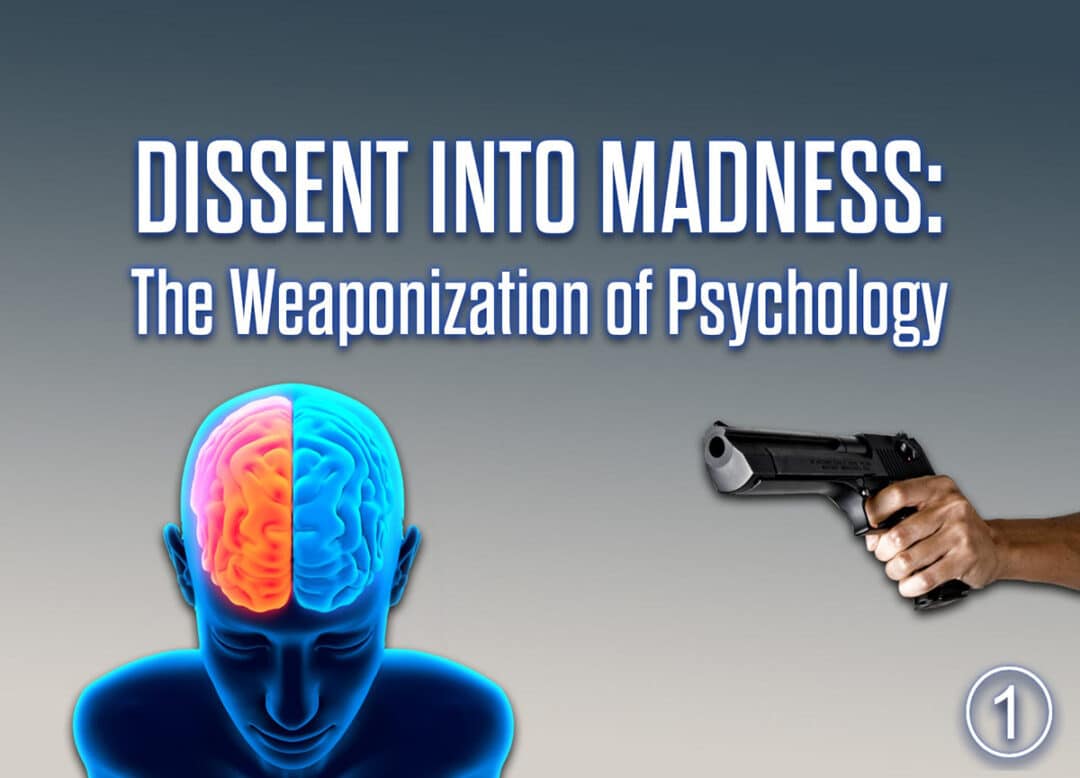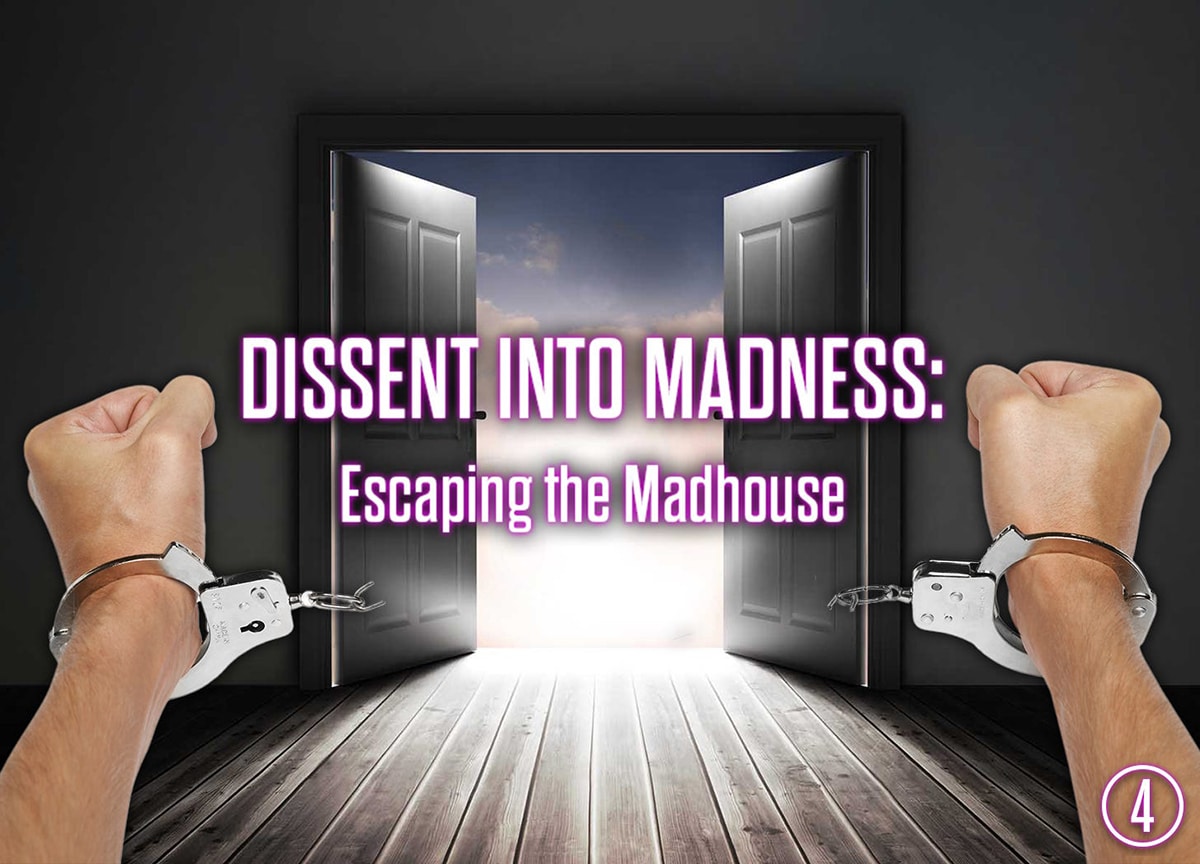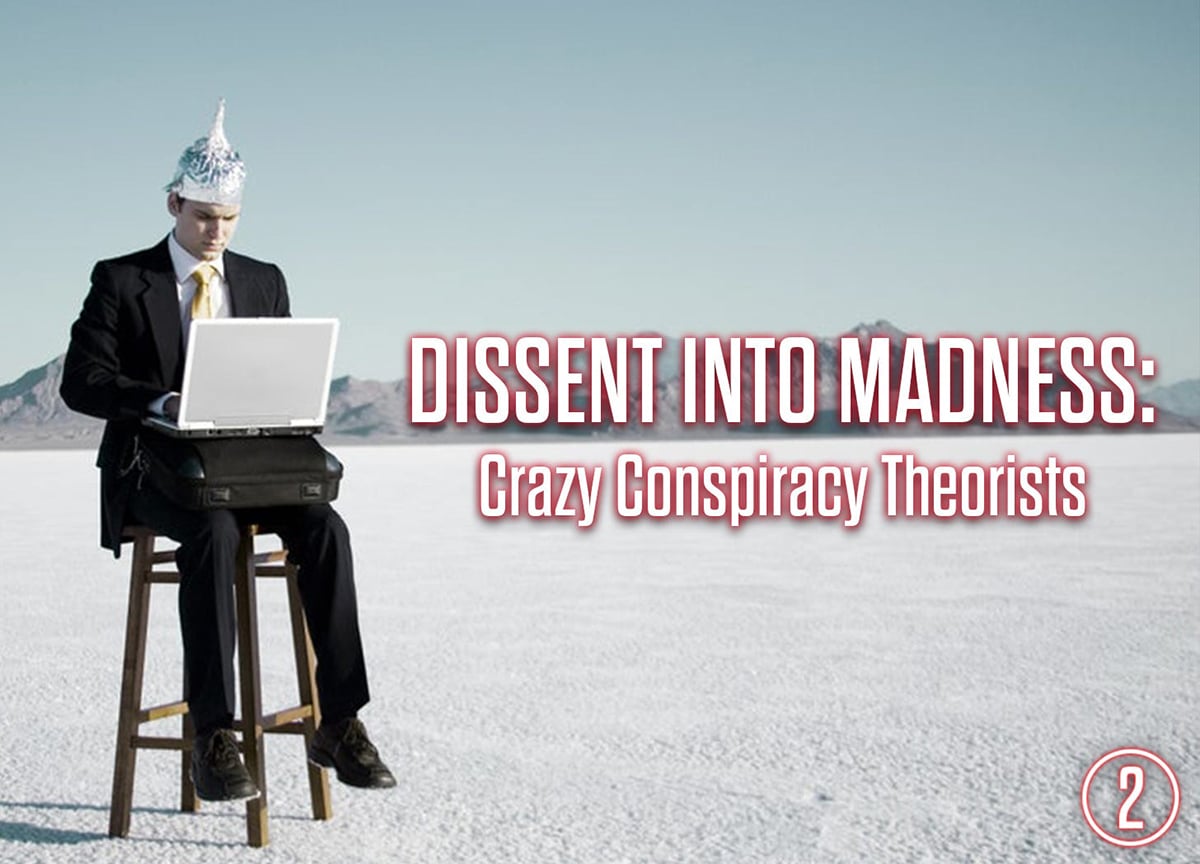

Dissent Into Madness: The Weaponization of Psychology
by | Mar 12, 2023
“WA State Bill Will Send Political Enemies to Psych Wards” blares a recent headline from Kurt Nimmo’s Substack.
The bill in question, Washington State Legislature House Bill 1333, “Establishing the domestic violent extremism commission,” would, according to its critics, “criminalize thought and expression under an invented category of offences called ‘domestic violent extremism'” and allow the state’s attorney general to “prosecute some people for words and speech, rather than violent acts.”
Although there is nothing in the bill itself declaring that “political enemies” of the state will be sent to “psych wards,” the idea that psychologists and psychiatrists might be employed on such a “domestic violent extremism commission” to diagnose political dissidents with some form of mental disorder is not a misplaced one.
In fact, as it turns out, there is a long and worrying history of psychiatry being used as a weapon to silence those declared to be enemies of the state. And, more worrying still, recent events have demonstrated that—far from being a relic of the past—the pathologization of political dissent is becoming even more widespread than ever before.
The Bad Old Days

The history of psychology is, to a large extent, the history of cruel and unusual punishments meted out by rulers on political dissidents.
That psychology has always been a convenient tool for the ruling class to wield against dissenters may seem like a controversial observation at first glance. But this is precisely what the most mainstream of establishment sources tell us . . . when they’re talking about the establishment’s enemies.
In 1983, for example, Dr. Walter Reich was afforded prime journalistic real estate in America’s newspaper of record, The New York Times, for a lengthy report on “The World of Soviet Psychiatry.” After reporting that the 1977 congress of the World Psychiatric Association in Hawaii had voted to condemn “the systematic abuse of psychiatry for political purposes in the U.S.S.R.,” Reich notes that “Western concern over pyschiatric abuse in the Soviet Union had only grown” since the congress’ vote and that “the Russians were in danger of being suspended or even expelled from the international psychiatric organization.”
Reich then spends the majority of the rest of his 6,000-word article contrasting the American approach to mental health—in which “psychiatric treatment has become acceptable enough during the last few decades for people in emotional distress to seek it out”—with the Soviet approach—in which “the need for psychiatric care is more likely to be seen as a cause for shame.”
The Soviets, we are told, had taken the honourable study of the human mind and weaponized it, turning it into an instrument of political oppression.
For years, Soviet psychiatrists had been accused in the West of diagnosing as mentally ill political dissidents they knew to be mentally well. According to both Western critics and Soviet dissidents, the K.G.B.—especially after it was taken over in 1967 by Yuri V. Andropov, now the top Soviet leader—had regularly referred dissidents to psychiatrists for such diagnoses in order to avoid embarrassing public trials and to discredit dissent as the product of sick minds. Once in psychiatric hospitals, usually special institutions for the criminally insane, the dissidents were said to be treated with particular cruelty—for example, given injections that caused abscesses, convulsions and torpor, or wrapped in wet canvas that shrank tightly upon drying.
Lest the reader be left in any doubt as to his message, Reich states it clearly later on in the piece: “[T]he experience of Soviet psychiatry had a lot to teach,” he tells us, “about the vulnerabilities of psychiatry to misuse wherever it is practiced.”
To be sure, Reich isn’t wrong. The horrors of the Soviet psychiatric system—in which political dissidents were routinely diagnosed with “sluggish schizophrenia,” psychiatric hospitals were used as temporary prisons during periods of protest, and troublesome rebels were kept in medically induced comas or drug-induced catatonic states for extended periods of time—has been well documented in numerous mainstream sources, both popular and academic. But these horrors were given their most poignant expression in the words of Alexander Solzhenitsyn:
The incarceration of free thinking healthy people in madhouses is spiritual murder, it is a variation of the gas chamber, even more cruel; the torture of the people being killed is more malicious and more prolonged. Like the gas chambers, these crimes will never be forgotten and those involved in them will be condemned for all time during their life and after their death.
As Reich correctly observes in his report, the Soviet pathologization of dissent does indeed serve as a warning that psychiatry is vulnerable to being misused “wherever it is practiced.” But, by a funny coincidence, these concerns only ever seem to come up when psychiatry is being “misused” in countries that are on the US State Department’s enemies list.
Thus, there are no shortage of sources that will tell you about:
- the abuses of Nazi psychiatrists, who sat on planning committees for the Aktion T4 euthanasia and sterilization program and who directed the Nazi regime’s horrific (and failed) attempt to eradicate schizophrenia by systematically killing off Germany’s schizophrenic population;
- the abuses that Japanese psychiatrists inflicted on their patients during and immediately after WWII, resulting in an abnormally large number of patient deaths;
- the Cuban revolutionary government’s use of psychotropic drugs and electroconvulsive therapy in order to obtain information from, punish, demoralize, coerce, subdue, terrorize, and cause psychological damage to those deemed a threat to state security;
. . . and any number of similar examples of psychiatric abuse by governments at war with or in the crosshairs of the US government.
Often excluded from this analysis, however, are the horrific abuses that psychiatrists in the West have inflicted on their patients in the name of state security.
For example, while the history books will rightly condemn the horrors of the Nazi eugenic sterilization program, they seldom explore the roots of that program. As it turns out, those roots were in the Kaiser Wilhelm Institute of Anthropology, Human Heredity, and Eugenics, which was funded by the Rockefeller Foundation. What’s more, Ernst Rüdin—the director of the also-Rockefeller-funded Kaiser Wilhelm Institute for Psychiatry and one of the key architects of Germany’s eugenics program—modeled the Nazi eugenics legislation on America’s own “Model Eugenical Sterilization Law.”
In fact, America’s first professor of psychology, James McKeen Cattell, helped bring the eugenics pseudoscience to the shores of America in the first place. Having befriended Francis Galton, the progenitor of eugenics, during a trip to England in 1887, Cattell returned to the US with an enthusiasm for the idea. He later wrote a letter to Galton bragging, “We are following in America your advice and example.”
Still further back in history, Benjamin Rush—one of the founding fathers of the United States and the man officially recognized by the American Psychiatric Association as the “father of American psychiatry”—made early contributions to the weaponization of psychiatry by inventing a number of mental disorders to pathologize dissent. The most notable of these made-up disorders was “anarchia,” a type of madness Rush defined as “an excess of the passion for liberty,” which “could not be removed by reason, nor restrained by government” and “threatened to render abortive the goodness of heaven to the United States.”
And what did this “father of American psychiatry” prescribe for those he deemed to be suffering from mental illness? Well, for starters, he “treated his patients with darkness, solitary confinement, and a special technique of forcing the patient to stand erect for two to three days at a time, poking them with sharp pointed nails to keep them from sleeping—a technique borrowed from a British procedure for taming horses.” He also invented two mechanical devices for the treatment of the insane: a “tranquilizing chair,” in which the patient’s “body is immobilized by straps at the shoulders, arms, waist, and feet [and] a box-like apparatus is used to confine the head,” and a “gyrator,” “which was a horizontal board on which torpid patients were strapped and spun to stimulate blood circulation.”
Rush’s apprentice, physician and outspoken germ theory critic Samuel Cartwright, made his own contribution to the field by inventing a disorder he named “drapetomania, or the disease causing negroes [slaves] to run away“:
The cause in the most of cases, that induces the negro to run away from service, is as much a disease of the mind as any other species of mental alienation, and much more curable, as a general rule. With the advantages of proper medical advice, strictly followed, this troublesome practice that many negroes have of running away, can be almost entirely prevented, although the slaves be located on the borders of a free state, within a stone’s throw of the abolitionists.
Yes, the history of psychiatry is replete with examples of political dissidents, unruly populations or other “social undesirables” being labeled as insane and sent to the madhouse . . . or worse.
But that was then, many would be inclined to argue. This is now. Surely psychiatry isn’t used to suppress dissent any more, is it? . . .
The Bad New Days

. . . It sure is! And I’m not just talking about psychiatric repression in some backward, evil dictatorship like Russia. (Although, to be sure, there is that, too.)
No, once again, it is the “liberal,” “enlightened,” “free and democratic” West that is leading the way in weaponizing psychiatry against the masses. And, incredibly, the wielders of this psychiatric weapon don’t try to hide the fact, but have instead actively sought to codify it in their “bible.”
Since 1952, the American Psychiatric Association has published the Diagnostic and Statistical Manual of Mental Disorders, or the DSM, as a guideline for the classification and diagnoses of mental health issues. Commonly referred to as the psychiatric diagnostic bible, the DSM, according to the APA itself, “is the standard classification of mental disorders used by mental health professionals in the United States and contains a listing of diagnostic criteria for every psychiatric disorder recognized by the U.S. healthcare system.”
Critics have long questioned the influence that Big Pharma has had in pressuring the APA to diagnose more and more behaviour as “abnormal” in order to prescribe pharmaceutical interventions to a greater and greater percentage of the public.
Concerns over Big Pharma’s influence on the creation of DSM are not trivial. In 2012, a study led by University of Massachusetts-Boston researcher Lisa Cosgrove noted that 69% of the DSM-5 task force members had ties to the pharmaceutical industry, including paid work as consultants and spokespersons for drug manufacturers. On certain panels, the conflict of interest was even more profound: 83% of the members of the panel working on mood disorders had pharamaceutical industry ties, and 100%—every single member—of the sleep disorder panel had “ties to the pharmaceutical companies that manufacture the medications used to treat these disorders or to companies that service the pharmaceutical industry.”
If these task force members’ goal is to make sure that more and more pharmaceuticals are sold, then by every measure they’ve been remarkably successful. Recent surveys indicate one in six American adults report taking a psychiatric drug, such as an antidepressant or a sedative. Worryingly, the number of children being prescribed antipsychotic medications like Adderall and Ritalin has continued to increase decade after decade.
But more worrying still is the way that this increase in antipsychotic prescriptions has been justified—by the invention of a new “mental disorder” called Oppositional Defiance Disorder.
Clinical psychologist Bruce Levin, who has spent decades ringing the alarm bell about the ways in which his profession is being used to repress legitimate political dissent, explains in his 2018 book, Resisting Illegitimate Authority:
Beginning in 1980, for noncompliant children who are not engaged in any illegal practices, the APA (in its DSM-III diagnostic manual) created the disruptive disorder diagnosis “oppositional defiant disorder” (ODD). For an ODD diagnosis, a youngster needs only four of the following eight symptoms for six months: often loses temper; often touchy or easily annoyed; often angry and resentful; often argues with authority figures; often actively defies or refuses to comply with requests from authority figures or with rules; often deliberately annoys others; often blames others for his or her mistakes or misbehavior; spitefulness or vindictiveness at least twice within the past six months.
Levine goes on to point out that the front line of this assault on the human psyche are the children who are diagnosed with a mental disorder for demonstrating previously normal childhood behaviour:
In 2012, the Archives of General Psychiatry reported that between 1993 through 2009, there was a sevenfold increase of children 13 years and younger being prescribed antipsychotic drugs, and that disruptive behavior disorders such as ODD and CD were the most common diagnoses in children medicated with antipsychotics, accounting for 63% of those medicated.
But the pathologization of those who show signs of “oppositional defiance” is not confined to children. Levine also observes, citing his own clinical experience:
Among the people I have talked with who have been previously diagnosed with psychiatric illnesses, I am struck by how many of them, compared to the general population, are essentially anti-authoritarians. Unluckily for them, the professionals who have diagnosed them are not.
As we shall see next week, the weaponization of psychology against those independent, free-thinkers who tend to question authority is not some vague, amorphous concern about a Big Pharma boondoggle that is hurting people in the pocketbook. Rather, this weapon is now being used against critics of the biosecurity agenda and others who dare point out that the globalist, transhuman emperor is wearing no clothes.
But if it is true that the study of the mind has been weaponized and that that weapon is being deployed against conspiracy realists, the obvious question then becomes . . .
Who Loaded the Weapon?

In October 1945, George Brock Chisholm—the man who would go on to serve as the first Director-General of the World Health Organization and the man who helped spearhead the World Federation for Mental Health—delivered a startling and incredibly candid lecture in which he laid out his plans for steering the profession of psychiatry in a bold new direction.
Published in 1946 as “The Reestablishment of Peacetime Psychiatry,” the lecture includes a bold proclamation that psychiatrists should take it upon themselves to rid the population of the concept of good and evil entirely: “If the race is to be freed from its crippling burden of good and evil it must be psychiatrists who take the original responsibility. This is a challenge which must be met.”
Perhaps unsurprisingly, Chisholm’s call to action was taken up by the British military. The “challenge” of “freeing the race” from the “crippling burden of good and evil” was taken up by British military psychiatrist Colonel John Rawlings Rees, the first president of Chisholm’s World Federation of Mental Health and chair of the infamous Tavistock Institute from 1933 to 1947.
In 1940, Rees gave an address to the annual meeting of the UK’s National Council for Mental Hygiene in which he laid out in predictably militaristic terms how this ambitious plan for reforming the public psyche was to be achieved. In “Strategic Planning for Mental Health,” Rees—after claiming that the psychiatrists of the council “can justifiably stress our particular point of view with regard to the proper development of the human psyche, even though our knowledge be incomplete”—asserts that they must aim to make that point of view “permeate every educational activity in our national life.”
He then launches into a startling confession:
[W]e have made a useful attack upon a number of professions. The two easiest of them naturally are the teaching profession and the Church; the two most difficult are law and medicine.” [. . .] “If we are to infiltrate the professional and social activities of other people I think we must imitate the Totalitarians and organize some kind of fifth column activity!”
Then Rees brazenly proclaims that “Parliament, the Press and other publications are the most obvious ways by which our propaganda can be got across” before reminding his audience once again of the need for secrecy if this plan to influence the development of the public psyche is to succeed: “Many people don’t like to be ‘saved’, ‘changed’ or made healthy,” he remarks.
So what were Rees and his fellow travelers really aiming at in their “fifth column” campaign to “attack” the professions and propagandize the public? His true intentions are revealed through his work for the British military—including his alleged drugging, poisoning and mesmerizing of Rudolf Hess, the Deputy Führer of the Nazi party who was captured and held by the British for decades after making a still-unexplained solo flight to Scotland in 1941—and through his work at the Tavistock Institute, where he attempted to mould public opinion in the UK to his liking.
As The Campaigner magazine explained in a Tavistock exposé published in 1978: “The theme of all of Rees’s known work is the development of the uses of psychiatry as a weapon of the ruling class.” That work, the article elaborates, included advising Rees’ superiors how they “can succeed in structuring a stressed individual’s or group’s situation appropriately, the victim(s) can be induced to develop for himself a special sort of ‘reaction formation’ through which he ‘democratically’ arrives precisely at the attitudes and decisions which the dictators would wish to force upon him.”
In other words, Rees’ work centered on the Problem-Reaction-Solution method of mass social control that Corbett Reporteers will be very familiar with by now. It should be no surprise, then, to learn that Rees’ research heavily influenced the operations of a budding young intelligence service that was then forming in the United States: the Central Intelligence Agency.
Indeed, the CIA has always been interested in weaponizing psychiatry as a way of achieving success in their covert operations. In fact, the CIA even openly advertises job opportunities for psychiatrists to “help the CIA mission where it intersects with psychiatric and broader behavioral issues.”
But when most people think of the CIA and weaponized psychiatry, they think of MKUltra and mind control.
As even the Wikipedia article on the subject admits, the CIA’s “Project MKUltra” was “an illegal human experimentation program designed and undertaken by the U.S. Central Intelligence Agency (CIA), intended to develop procedures and identify drugs that could be used in interrogations to weaken individuals and force confessions through brainwashing and psychological torture.”
There is much that the public still does not know about this project, its forerunner programs, Project Bluebird and Project ARTICHOKE, and the depths to which agents of the US government sank to discover ways of manipulating, melding, erasing or reprogramming individuals’ psyches. But what we do know about the program is chilling enough.
One series of experiments, presided over by Sidney Gottlieb, involved administering LSD to unwitting Americans, including mental patients, prisoners, drug addicts and prostitutes. This included “Operation Midnight Climax,” in which unsuspecting men were drugged and lured to CIA safe houses by prostitutes on the CIA payroll. Their sexual activity was monitored behind one-way mirrors and was used to study the effect of sexual blackmail and the use of mind-altering substances in field operations.
Another experiment, dubbed MKULTRA Subproject 68, was overseen by the esteemed psychiatrist Dr. Ewen Cameron. This subproject involved Dr. Cameron using LSD, paralytic drugs, electroshock therapy and drug-induced comas to attempt to wipe patients’ memories and reprogram their psyche. When brought to light, the program was identified as an attempt to refine methods of medical torture for the purpose of extracting information from unwilling sources and was condemned. Lawsuits regarding the blatantly illegal experimentation conducted by Cameron continue into the current era.
Although MKUltra “officially ended” after its exposure in the 1970s, the CIA has not stopped employing psychiatrists to find new and innovative ways to psychologically torment their opponents.
In May 2002, Martin Seligman, an influential American professor of psychology and a former president of the American Psychological Association, delivered a lecture at the San Diego Naval Base explaining how his research could help American personnel to—in his own words—”resist torture and evade successful interrogation by their captors.”
Among the hundred or so people in attendance at that lecture was one particularly enthused fan of Selgiman’s work: Dr. Jim Mitchell, a military retiree and psychologist who had contracted to provide training services to the CIA. Although Seligman had no idea of it at the time, Mitchell was—as we now know—one of the key architects of the CIA’s illegal torture program.
Naturally, Mitchell’s interest in Seligman’s talk was not in how it could be applied to help American personnel overcome learned helplessness and resist torture but rather how it could be used to induce learned helplessness in a CIA target and enhance torture. As it turns out, Mitchell’s theory (that “producing learned helplessness in a Qaeda interrogation subject might ensure that he would comply with his captor’s demands”) was bogus. More experienced interrogators objected at the time, noting that torture would only induce a prisoner to say what his captor wants, not what he knows.
What those interrogators didn’t understand was that extracting false confessions from prisoners was actually the point of the CIA torture program. It was “confessions” extracted under torture, after all, that went on to form the backbone of the 9/11 Commission Report, with a full quarter of all of the report’s footnotes deriving from torture testimony.
The Worst is Yet to Come . . .
Yes, from mind control experiments to torture programs to brainwashing and lobotomization, there can be no doubt that the governments. militaries and intelligence agencies of every major nation have devoted considerable resources to the weaponization of psychiatry over the course of the past century.
But, as it turns out, one of the simplest and easiest techniques for controlling dissent is simply to pathologize it. As we are beginning to see, simply declaring resistance to the status quo to be a form of mental disorder can be an exceptionally powerful tool for silencing opposition.
Next week, we will examine the ways this technique is now being employed against the conspiracy realists who seek to point out the obvious truths about the homeland security state and the biosecurity state.
Stay tuned . . .




